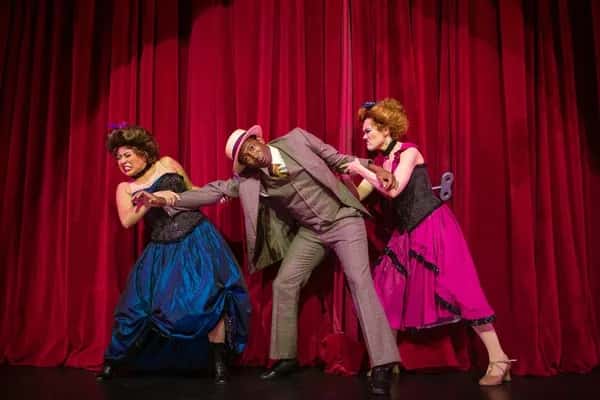
Seeing “Follies” is like spotting the Bigfoot of Broadway history: It’s the stuff of legend, even when it lumbers a bit. The current San Francisco Playhouse production more than does justice to this rarely revived classic of the Sondheim canon.
Playhouse artistic director Bill English is at the helm of the Bay Area’s first-ever professional staging of this 1971 backstage psychodrama about a late middle-age reunion of Ziegfield-style showgirls decades after their days in the kick line. And he’s got his work cut out for him: “Follies” has a multigenerational cast of 21, some of Sondheim’s most labyrinthine lyrics and one of the more unorthodox (and, yes, ungainly) narrative structures in Broadway musical history. The show is eye-popping, heartwrenching and fully engaging.
At its opening “Follies” seems to be offering a “Big Chill”-like group portrait of five female characters. But after three of them each get a single character song (One of which, “I’m Still Here”—performed by Cindy Goldfield as jaded starlet Carlotta—is an early high point of the show), they’re elbowed to the margins as the focus zooms in on the remaining two former chorines, Sally (Natascia Diaz) and Phyllis (Maureen McVerry), whose tumultuous relationships with their husbands Buddy (Anthony Rollins-Mullens) and Ben (Chris Vettel) become the anginal heart of the show.
A musical theater counterpart to the quarrelsome quartet of “Who’s Afraid of Virginia Woolf” these couples are brilliantly played, but often tough to take. Sondheim and book writer Goldman were decades ahead of their time in probing the complex psychology of longterm marriages with the kind of detail that today tends to be played out more slowly over prestige cable and streaming series. Compacted into two-and-a-half dizzying hours that also packed with song and dance, this palpably neurotic foursome’s unpredictable swings between comic and creepy extremes comes close to overwhelming.
Knockout performances
That said, the performances are extraordinary: McVerry provides a running subtext to her lines with deftly timed wrist flips and eyebrow arches. Rollins-Mullins undergirds unfaithful Buddy with an empathic humanity that shines through even his nastiest outbursts. Diaz gives Sally an on-the-brink-of-breaking emotional fragility; a spooky mash-up of Laura Wingfield in “The Glass Menagerie” and Karen Black in, well, in general. And Vettel makes Ben the hollowest of hollow men, a sort of slap-happy Jay Leno-Mike Pence hybrid.
A younger actor shadows each of the central foursome, playing earlier more idealistic versionsof the same characters, frequently on stage alongside their elder selves. It’s a tricky conceit, but director English not only keeps things clear, but along with choreographer Nicole Helfer, leverages these duos to create some of the evening’s most moving moments. When Buddy and his younger self (Chachi Delgado) dance with imaginary partners while singing “The Right Girl”, the self-realizing romance between man and boy across time feels more honest and rewarding than either’s fantasy of married coupledom.
More time-warped mirror images are on tap when Sally, Phyllis and the other former showgirls perform with their own younger selves in the Busby Berkeley-style showstopper, “Who’s That Woman”; the younger actresses wearing costume designer Abra Berman’s spectacular white-feathered headdresses and sparkling bodysuits.
With the central quartet, their youthful doppelgangers, and plenty of secondary characters—in addition to the trio of igneous Rockettes there’s the one-time impresario who mounted their revues, the emcee who warmed up their way-back-when audiences, and a couple of sexy male dancers—the Playhouse stage can start to feel crowded. But English and Helfer make the most of that circumstance, turning what could have been traffic jams of blocking and choreography into Felliniesque dream tableaux.

Lopsided highlights
A final coup of narrative strangeness occurs late in the evening when forward motion is set aside for an unexpected burlesque MRI of the leading characters brains: Four terrifically executed, though almost entirely redundant, novelty numbers sum up their states-of-mind (Or, in the case of Sally, her state of “Losing My Mind”).
These are among the best set pieces in the show, with McVerry tearing up the floor in a Latin-inflected dance with her own inner devils and Rollins-Mullens delivering the night’s highest high with “Buddy’s Folly” (aka “The God Why Don’t You Love Me Blues”) but while they slightly deepen already familiar personality traits they also lengthen the show with even more information about characters we know well, they further squeeze the rest of the ensemble off to the edges. This is a book problem long noted by critics—and a lesson that seems well-learned by the creators of the more tidily democratic A Chorus Line” which debuted just a few years after “Follies.”
San Francisco Playhouse’s “Follies” is not a reimagining of this gargantuan, seldom seen work; it’s a faithful, frequently thrilling revival that unapologetically puts a shine on every wart and carbuncle. While certainly a must-see for aficionadoes of Broadway musical history, it also offers a trenchant exploration of marriage that feels surprisingly undated even after 51 years, the most intellectually acute choreography of the season, and a heaping reminder of Stephen Sondheim’s always ambitious artistic genius.
To miss it would be your folly.

